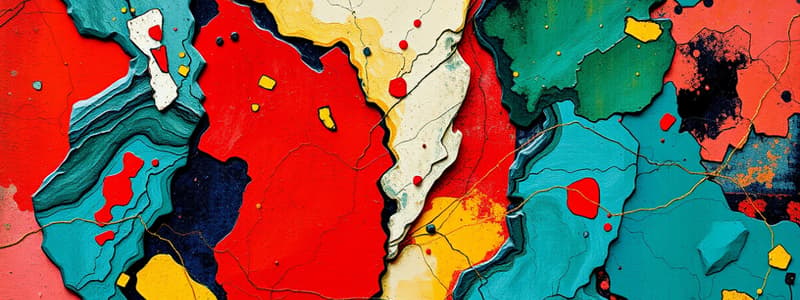Podcast
Questions and Answers
Which metal has the highest concentration by weight in the Earth's crust?
Which metal has the highest concentration by weight in the Earth's crust?
- Copper
- Iron
- Aluminum
- Silicon (correct)
Gold has a higher concentration in the Earth's crust than uranium.
Gold has a higher concentration in the Earth's crust than uranium.
False (B)
What is an ore deposit?
What is an ore deposit?
An occurrence of minerals or metals in sufficiently high concentration to be profitable to mine and process.
The typical grade for aluminum is ______ by weight.
The typical grade for aluminum is ______ by weight.
Match the following metals with their typical grades in ore deposits:
Match the following metals with their typical grades in ore deposits:
What is the primary cause of banded iron formations (BIF)?
What is the primary cause of banded iron formations (BIF)?
Geysers are an example of hydrothermal ore deposits.
Geysers are an example of hydrothermal ore deposits.
What does beneficiation refer to in mineral processing?
What does beneficiation refer to in mineral processing?
The concentration of minerals caused by high temperatures and pressures is primarily found in ___________________ ore deposits.
The concentration of minerals caused by high temperatures and pressures is primarily found in ___________________ ore deposits.
Match the following exploration methods with their descriptions:
Match the following exploration methods with their descriptions:
Which mineral accumulation occurs in evaporite deposits?
Which mineral accumulation occurs in evaporite deposits?
Damage to rocks occurs exclusively during hydrothermal processes.
Damage to rocks occurs exclusively during hydrothermal processes.
What determines the recoverability of ore?
What determines the recoverability of ore?
Which metal typically deposits first as magma cools?
Which metal typically deposits first as magma cools?
Hydrothermal solutions are released during the solidification of magma.
Hydrothermal solutions are released during the solidification of magma.
What type of deposits form from the deposition of dense and resistant minerals in streams?
What type of deposits form from the deposition of dense and resistant minerals in streams?
Solidification of magma releases water referred to as ________ solution.
Solidification of magma releases water referred to as ________ solution.
Match the following minerals with their typical concentrations:
Match the following minerals with their typical concentrations:
Which of the following minerals is NOT typically mentioned with hydrothermal ore deposits?
Which of the following minerals is NOT typically mentioned with hydrothermal ore deposits?
Hydrothermal fluids can be associated with contact metamorphism.
Hydrothermal fluids can be associated with contact metamorphism.
Name one location where hydrothermal fluids are commonly associated with geological processes.
Name one location where hydrothermal fluids are commonly associated with geological processes.
Study Notes
Importance of Geology
- Geology enables understanding of earth materials, aiding in resource extraction and environmental management.
Concentrations of Economically Important Metals
- Aluminum: 8.0% in Earth’s crust; economically viable at 30% concentration.
- Iron: 5.8% in crust; typically found at 53% grade.
- Copper: 0.0058%; economic recovery feasible at 0.5-4% grade.
- Nickel: 0.0072%; commonly occurs at 1% grade.
- Zinc: 0.0082%; mined at a grade of 4%.
- Uranium: 0.00016%; suitable for extraction at 0.3% grade.
- Lead: 0.001%; profitable at 5% grade.
- Silver: 0.000008%; typical grade for mining is 0.01%.
- Gold: 0.0000002%; extraction possible at grades between 0.0001-0.001%.
Ore Deposits
- Ore deposit defined as a concentration of minerals/metals profitable for mining and processing.
- Ore grade indicates concentration of economic minerals, measured in weight percentage or grams/tonne for precious metals.
Ore Deposit Concentration
- Typical ore grades vary significantly from crustal concentrations; economic viability depends on meeting or exceeding these grades.
Formation of Ore Deposits
- Crystal Settling: Metals like silicon and aluminum crystallize first as magma cools.
- Hydrothermal Deposits: Formed by precipitation of minerals from hydrothermal solutions in veins or rock cracks.
- Sedimentary Deposits: Include alluvial (placer gold) and evaporite deposits (potash, salt), formed from mineral accumulation in water bodies.
- Banded Iron Formation (BIF): Characterized by alternating chert and iron bands, important for understanding Earth's oxygenation.
Types of Ore Deposits
- Metamorphic Deposits: Concentrated by heat and pressure, found near magma intrusions; notable examples include diamonds and garnets.
- Hydrothermal Zoning: Alternation of minerals by hydrothermal solutions influences ore grades.
Exploration Methods for Ore Deposits
- Utilize remote sensing, geological mapping, geophysical and geochemical surveys, bulk sampling, and drilling techniques for resource identification.
Geophysical Methods
- Airborne Geophysics: Involves using specialized aircraft and equipment to analyze geological formations and identify potential mineral deposits.
Geochemical Analysis
- Identifies geochemical anomalies to detect areas with higher concentrations of valuable metals.
Beneficiation Process
- Aims to enhance the economic value of ore by separating gangue minerals, resulting in higher-grade concentrates and a distinct waste stream (tailings).
Studying That Suits You
Use AI to generate personalized quizzes and flashcards to suit your learning preferences.
Related Documents
Description
This quiz delves into the basics of geology, focusing on economically important metals and their concentrations in the Earth's crust. It covers key concepts such as what constitutes an ore deposit and the relevance of various metals like aluminum, iron, and gold. Test your knowledge on these fundamental geological principles!




